The hormone cycle
There are 4 key hormones involved in your menstrual cycle, these are follicle-stimulating hormone (FSH), luteinising hormone (LH), oestrogen and progesterone. The image below shows the characteristic pattern of these hormones across your menstrual cycle.
- Oestrogen
- Progesterone
- Luteinising Hormone (LH)
- Follicle-Stimulating Hormone (FSH)
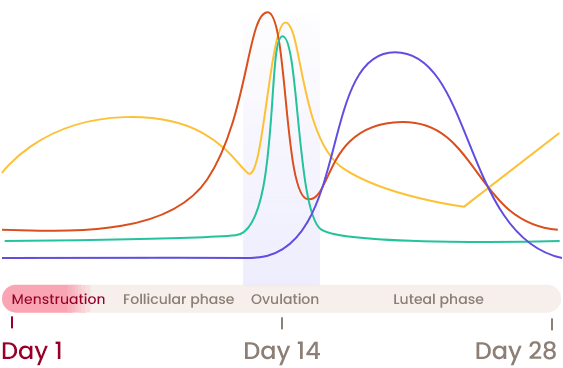
Day 3
Oestrogen, Progesterone, and LH are low while FSH is increasing. This is when most hormone tests are taken.
Day 14
Oestrogen, LH and FSH begin to rise, and peaks sharply when you ovulate. After ovulation, Progesterone rises to prepare the body for pregnancy. If pregnancy hasn't occurred, Progesterone levels decline, and you'll have a period.
Changes during perimenopause
When you enter perimenopause, this pattern begins to change as your oestrogen and progesterone levels slowly decline, causing FSH and LH levels to rise in an attempt to trigger the ovaries to produce more hormones.
The slow decline in oestrogen and progesterone does not happen in a linear pattern. It's much more erratic, making it difficult for current female hormone tests taken on a single day to pick up these changes - especially if it's just testing FSH.
MyFORM® is the only blood test in the UK that can identify if your progesterone, oestrogen, LH and FSH are fluctuating in the correct pattern throughout your menstrual cycle.
Get a full insight into your hormones
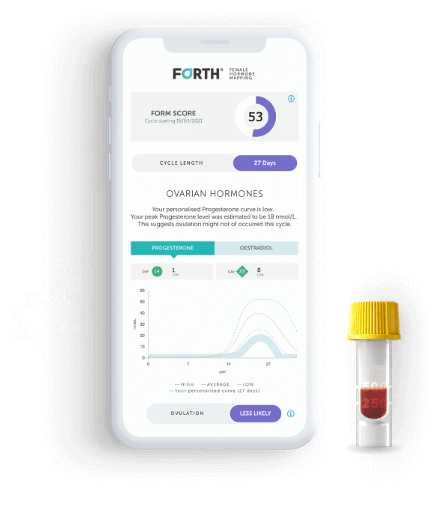
Hormones shouldn't be a mystery.
Our ground-breaking hormone mapping blood test means you can finally understand your hormones across your entire menstrual cycle, helping you to better understand your body and improve your wellbeing.
This test is ideal for women who are not on hormonal contraception or HRT. For those who are, we recommend our Female Hormone Imbalance test.
MyFORM® Female Hormone Mapping
Check fertility, hormone imbalance or hormone-related conditions with our ground-breaking hormone mapping test.
NHS lab analysis
x2 finger prick home blood sample kits
Comprehensive hormone report
Tracked 24 delivery & return
Results within 3-5 working days of receiving your second sample
£129
3 Interest-free payments
Learn more

Validated & analysed by NHS Lab
Certified for quality & security
Shop now. Pay over time with Klarna
Klarna available at checkout.
Klarna's Pay in 3 / Pay in 30 days are unregulated credit agreements. Borrowing more than you can afford or paying late may negatively impact your financial status and ability to obtain credit. 18+, UK residents only. Subject to status. Ts&Cs and late fees apply.

Your hormones affect all areas of your health
Hormone imbalances can cause various symptoms or health issues including irregular periods, mood changes, period pain or difficulties conceiving.
If you’re a woman under 40 (and not on HRT or hormonal contraception), our MyFORM® hormone mapping test can help you finally get to the bottom of how your hormones are affecting your health and fertility. Our unique test analyses your hormones across your entire menstrual cycle, giving you deeper insights than single day tests.
We measure all four key hormones during your cycle using two tests
Did you know, there are four key hormones in your menstrual cycle – oestrogen, progesterone, follicle-stimulating hormone and luteinising hormone – and they follow a typical pattern?
+ Read more about hormones
MyFORM® tests all 4 of these hormones. Combining lab analysis with AI we use sophisticated mathematical modelling to map how these hormones fluctuate across your entire menstrual cycle. MyFORM® is the only blood test in the UK that can identify your unique hormone pattern, which is what makes it so revolutionary.
To do this, we only need 2 blood samples taken on day 14 and day 21 of your menstrual cycle, and the process is super easy.
If your menstrual cycle is less than 22 days or more than 40 days, then we recommend our Female Hormone Imbalance test.
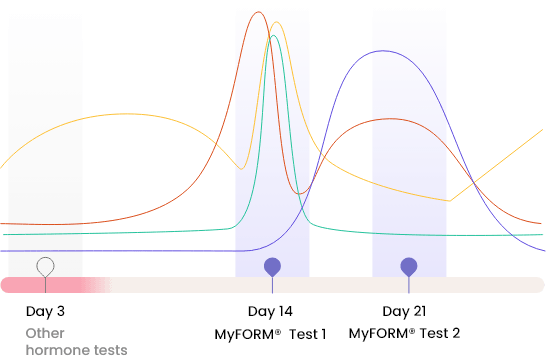
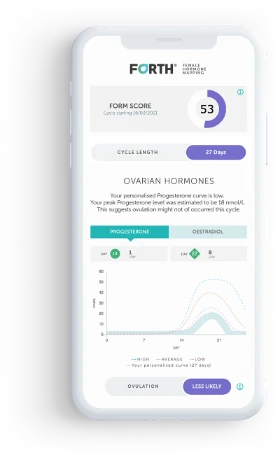
We send you your own, detailed hormone report
You’ll receive a detailed report from our doctors that includes your own, personalised hormone map, results for each hormone tested, your unique ovarian response score (FORM score) which tells you how well your ovaries are functioning. Your report will be delivered within 3-5 working days of your day 21 sample reaching our lab and can be viewed in your results app.
We use the results to help improve your wellbeing
Our hormone expert will give you the knowledge, advice and tools to help you understand if your hormones are fluctuating as expected for your age, if your symptoms are due to an imbalance, and manage any existing hormone related conditions.
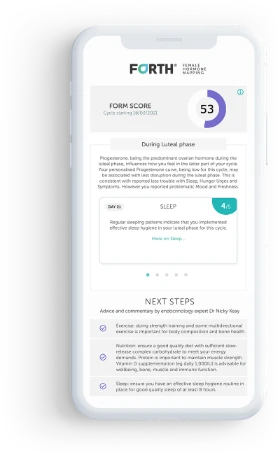
Why MyFORM® is ground breaking
"MyFORM® is our ground breaking female hormone mapping tool. With just two samples, we can map your entire cycle. With this never-before-seen insight, we can understand how your hormones are interacting with each other and give tailored advice about the health of your hormone network and how lifestyle changes can impact on your menstrual health as well as identifying any problems that can then be addressed. "
Dr Thom Phillips
WHAT'S THE PROCESS?
The process is easy
We send you a simple finger prick test kit for you to do at home.
You take two samples: one on day 14 of your cycle, and one on day 21. (Don't worry, we'll tell you when this is!).
You post the samples back to us, free of charge.
We analyse your samples in our NHS lab.
3-5 working days after we've received your second sample you'll get your personalised hormone report.
Join the women's health revolution.
An excellent service, I got fast replies to my enquires and immediate practical solutions. I needed my results quickly after being unable to get samples on my first attempt and Forth found a resolution for me and assisted at each stage. Really great communication from individuals who have the knowledge and ability to sort things out. Wouldn't go anywhere else.
Katie Murray
MyFORM® Female Hormone Mapping
NHS lab analysis
x2 finger prick home blood sample kits
Comprehensive hormone report
Tracked 24 delivery & return
Results within 3-5 working days of receiving your second sample
Frequently asked questions
This is what our customers ask us most about this test. For more information, try our help centre.
What should I do if my day 14 or 21 falls on a Fri through Sun?
If your day 14 or 21 falls on a Friday, we recommend you collect your sample the day before. If your day 14 or 21 falls over the weekend, collect your sample on the following Monday and remember to post in a priority post box in time for that day’s collection.
Should I change the test days if I have a longer or shorter cycle?
No, our algorithm will adjust your curves to the length of your personal cycle, so it is important that you collect your samples as close to day 14 and 21 as possible, even if you have a longer or shorter than average cycle.
What will the report tell me?
Your report will indicate if your symptoms are likely to be due to perimenopause.
You’ll get a detailed, personalised report with next step actions from an endocrinology expert. The report will tell you:
- If your symptoms are likely due to perimenopause
- Graphs indicating how each hormone fluctuates across your unique cycle
- Your FORM – ovarian response – score indicating how well your ovaries are responding to your control hormones – an indicator of perimenopause
- Personalised ranges for each of the 4 hormones tested on day 14 and day 21
- Confirmation if ovulation has occurred
- Clear next steps and actionable advice
What is a menstrual cycle?
The menstrual cycle is the almost monthly pattern the female body follows where the four sex hormones rise and fall significantly in a complex pattern that regulate the release of an egg from the ovaries. There are four phases to the menstrual cycle: Menstruation, Follicular Phase, Ovulation, and the Luteal Phase. Women can expect to have periods for around 30 years. The average menstrual cycle length is 28 days, but can range between 24 and 35 days.
What causes menstrual cycles to stop?
The most common cause of the end of menstrual cycles is when a woman reaches the menopause. This is defined as 12 months or more since the last period and usually occurs when aged between 45 and 55. There are 3 stages of the menopause: perimenopause, menopause, and postmenopause. Each stage has its own set of symptoms and challenges.
Another leading reason for menstrual cycles stopping is amenorrhea. This is defined as missing 3 or more periods in a woman of reproductive age. This is commonly a sign of hormonal imbalance. Amenorrhea can be caused by a number of health conditions or lifestyle factors such as overtraining (RED-S), high levels of stress, poor sleep, and poor diet.
Why is my menstrual cycle getting shorter or longer?
Changes in the menstrual cycle, including a lengthening of the cycle, can be influenced by various factors like stress, weight changes, or underlying health conditions.
Stress (Prolactin levels too) can have a significant impact on hormone levels, potentially leading to irregularities in your menstrual cycle. High stress levels can disrupt the normal functioning of the hypothalamus, affecting the regulation of hormones.
Significant weight loss or gain can affect hormone levels. This can be due to alterations in body fat percentage, which influences hormone production.
Thyroid disorders can affect hormone levels and menstrual cycle regularity. An overactive or underactive thyroid can lead to irregular periods.
PCOS is a hormonal disorder that can cause irregular periods and affect the length of the menstrual cycle. It’s often associated with higher androgen levels and multiple cysts on the ovaries.
As women approach menopause, the length and regularity of their menstrual cycles can change. Periods might become irregular and the cycle may lengthen as menopause approaches.
Pregnancy can lengthen the time between periods.
What are the 4 stages of the menstrual cycle?
The four stages of the menstrual cycle are Menstruation, Follicular Phase, Ovulation, and the Luteal Phase. You can learn more about the stages of the menstrual cycle on our blog.
Can this test help me screen for perimenopause?
In addition to providing a detailed view of your hormones, MyForm can be used to identify the signs that you have entered perimenopause.
Can I take this test while using hormonal contraception?
MyFORM’s analysis is not compatible with someone taking hormonal contraception. This is because hormonal contraceptive products change the natural hormonal picture, making any test result meaningless. If you’ve been taking hormonal products, consider waiting for your natural cycle to return or a period of 8-12 weeks before using the test. We recommend either Female Hormone or Menopause Health Check.
How soon will the test arrive?
If you order your test before midday on a Monday to Friday then your kit will be dispatched
the same day.
All our kits are sent out via Royal Mail first class post, so it should be with you within 1-2
working days.
How secure is my data?
We have strict processes in place to ensure the protection of your data. Following GDPR the company also operates under tight legal rules about the sharing of data which ensures that data is only shared if it is crucial to the delivery of our service. For example, our doctors see customer results at the time of review, however, after review, access to results is withdrawn.
Learn more about your data security.
Can I have someone take my blood for me?
Yes. We offer two options if you do not want to do our finger prick test. The first is a home appointment where a nurse comes to your home to take a blood sample. The second is to visit a Phlebotomy clinic near you that offers a blood sample service.
A blood sample will be taken from your vein and we will provide you with everything you need to give to the nurse to allow them to take the sample.
The nurse will give you the blood sample to return to us using the pre-paid envelope provided.
Does a doctor review my results?
We have a team of doctors and nurses who look at all results and will comment on any results that are outside of the normal range for your age.
Can I download the results to share with my GP?
Yes, you can download your results from your health dashboard as a PDF to share with your GP.
Learn how to export your results.
We are dedicated to supporting you on improving your health
Go to help center
MyFORM® Female Hormone Mapping
£129
Add to basket


